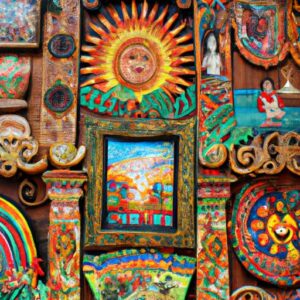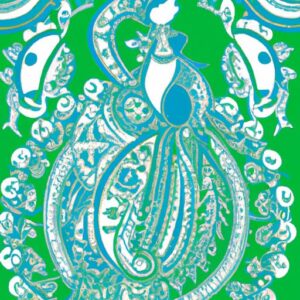Introduction
Welcome, dear reader, to a captivating journey into the vibrant world of the Inupiaq culture. In this article, we will delve into the enchanting realm of the Inupiaq people, focusing on the profound significance of their traditional art. Allow me to introduce you to the mesmerizing tapestry of colors, symbols, and techniques that define the traditional art of the inupiaq.
A. Overview of the Inupiaq culture
To truly appreciate their art, we must first understand the Inupiaq culture itself. The Inupiaq people are indigenous to the Arctic regions of Alaska and Canada, where they have thrived for countless generations. Their deep connection with nature and profound respect for the land and wildlife shape their way of life.
B. Significance of traditional art in Inupiaq heritage
Art is not merely a form of expression for the Inupiaq; it is an essential pillar of their heritage. Traditional art serves as a vehicle for storytelling, preserving history, and transmitting cultural values across generations. Each masterpiece carries the weight of ancestral wisdom, reflecting the Inupiaq’s deep-rooted traditions and worldview.
C. Introduction to the traditional art of the Inupiaq people
Now, let us embark on a visual expedition into the fascinating world of Inupiaq art. From intricate carvings to exquisite skin sewing and basketry, their art encompasses a diverse range of mediums and techniques. The traditional art of the Inupiaq is a testament to their ingenuity, resourcefulness, and profound connection with the environment.
As we continue our exploration, we will uncover the captivating history behind Inupiaq art, unravel the symbolism and themes interwoven within their masterpieces, and witness the contemporary adaptation of this ancient art form. So, buckle up and prepare to be enthralled by the timeless beauty of the traditional art of the Inupiaq.
History of Inupiaq Art
A. Origins of traditional Inupiaq art
Let us embark on a journey back in time, to the very origins of traditional Inupiaq art. Rooted in the depth of their cultural heritage, Inupiaq art has its roots in ancient practices that have been passed down through generations. The art forms we witness today have their foundations in the rich traditions and customs of the Inupiaq people.
B. Evolution and development of Inupiaq artistic practices
Over the centuries, Inupiaq art has evolved and adapted, reflecting the changing times and influences of the world around them. The artistic practices of the Inupiaq people have developed and refined, showcasing their remarkable creativity and ingenuity. From the earliest carved utensils and tools to intricate sculptures, each artistic endeavor tells a unique story of growth and evolution.
C. Influence of neighboring cultures on Inupiaq art
While the Inupiaq people have maintained a distinct artistic identity, it is essential to recognize the influence of neighboring cultures on Inupiaq art. The connections between Arctic indigenous communities have fostered the exchange of ideas, techniques, and materials. The artistic exchanges with neighboring cultures have enriched Inupiaq art, adding new dimensions and expanding the artistic horizons of the Inupiaq people.
As we delve deeper into the history of Inupiaq art, we will uncover the fascinating stories behind its origins, witness the remarkable evolution of artistic practices, and explore the remarkable interplay between Inupiaq art and the world around them.
Symbolism and Themes in Inupiaq Art
Art, in its many forms, serves as a powerful medium for cultural expression. In the realm of Inupiaq art, symbolism plays a central role, weaving intricate narratives and conveying profound meanings. Let us now embark on a journey to explore the mesmerizing world of symbols and themes within Inupiaq artwork.
A. Exploration of common symbols and motifs in Inupiaq artwork
Inupiaq art brims with a rich tapestry of symbols and motifs, each carrying a unique significance. The sun, moon, stars, and celestial bodies symbolize guidance, balance, and the passage of time. Animal figures, such as whales, bears, and birds, represent the interdependence between humans and nature, honoring the vital connections forged between species.
Delicate etchings of traditional tools, like the ulu (a curved knife) and the harpoon, depict the Inupiaq’s reliance on the land and sea for sustenance. Other common symbols include geometric patterns, waves, and spirals, each with its own hidden meanings waiting to be unraveled.
B. Representation of nature and wildlife in Inupiaq art
Nature holds a sacred place in the hearts of the Inupiaq people, and their art beautifully captures the essence of the Arctic landscape. Through intricate carvings, vibrant paintings, and detailed sculptures, they pay homage to the awe-inspiring wildlife that surrounds them. Majestic polar bears, graceful caribou, and magnificent whales come to life, breathing vitality into their artistic creations.
Inupiaq artists skillfully depict the interconnectedness between humans and the natural world, highlighting the delicate balance that sustains their culture. With every stroke of the brush or chisel, they invite us to marvel at the beauty of the Arctic ecosystem and recognize the importance of preserving it for future generations.
C. Cultural and spiritual significance of symbols in Inupiaq art
Symbols in Inupiaq art transcend mere aesthetics; they carry deep cultural and spiritual significance. Each symbol serves as a window into the Inupiaq worldview, offering insights into their beliefs, values, and traditions. Through their art, the Inupiaq people honor their ancestors, express gratitude to the spirits that guide them, and celebrate the interconnectedness of all living beings.
The symbols, motifs, and themes present in Inupiaq art invite us to reflect on our own connection to the natural world and the importance of preserving indigenous cultures and traditions. As we engage with their art, we are reminded of the universal human longing for harmony with nature and a sense of belonging within the intricate tapestry of life.
Traditional Inupiaq Art Techniques
A. Overview of traditional materials used in Inupiaq art
The traditional art of the Inupiaq is intimately intertwined with the resources found in their natural surroundings. From walrus ivory and whalebone to soapstone and driftwood, the materials used in Inupiaq art are meticulously sourced from the bountiful Arctic environment. Each material carries its own unique character and symbolism, adding depth and authenticity to the artwork.
Inupiaq artisans have mastered the art of transforming these raw materials into stunning works of art. They carefully select and prepare the materials, ensuring their durability and suitability for their intended purpose. The result is a harmonious blend of nature and craftsmanship, where the beauty of the material enhances the artistic expression.
B. Techniques employed in carving and sculpting
Carving and sculpting are central to Inupiaq art, with the skillful hands of artisans giving life to their visions. Inupiaq carvers utilize an array of tools, ranging from knives and chisels to files and sandpaper, to shape the materials into intricate, awe-inspiring creations. The process requires immense patience, precision, and a deep understanding of the material’s properties.
Whether it’s the fluid lines of a walrus tusk carving or the intricate details on a mask, the mastery of carving techniques is evident in every piece. The art of sculpting, on the other hand, allows Inupiaq artisans to create three-dimensional representations of animals, humans, and mythical creatures, capturing the essence and spirit of their subjects.
C. Introduction to skin sewing and basketry
In addition to carving and sculpting, the Inupiaq people excel in the art of skin sewing and basketry. Skin sewing involves the meticulous stitching of animal skins, primarily from seals and caribou, to craft clothing, footwear, and other functional items. The skill and precision required to create garments that protect against the harsh Arctic climate are a testament to the Inupiaq people’s resilience and ingenuity.
Basketry, on the other hand, showcases the Inupiaq people’s exceptional weaving skills. Utilizing grasses, roots, and other plant materials, they meticulously create baskets and containers, blending practicality with intricate designs. These baskets serve various purposes, from carrying and storing food to serving as beautiful decorative pieces.
Contemporary Adaptation of Inupiaq Art
A. Modern influences on the traditional art of the Inupiaq people
Art, like any other aspect of culture, is not immune to the winds of change. The traditional art of the Inupiaq has gracefully embraced modern influences, allowing for the evolution and growth of this rich artistic tradition. Today, contemporary elements find their way into Inupiaq art, infusing it with new perspectives and fresh inspiration. From modern tools and materials to innovative techniques, the Inupiaq artists skillfully blend tradition with innovation.
B. Revival and preservation efforts of Inupiaq art forms
Recognizing the importance of preserving their cultural heritage, the Inupiaq community has united in their efforts to revive and safeguard traditional art forms. Through dedicated initiatives, local organizations, and educational programs, they ensure that the knowledge and skills required for Inupiaq art are passed down to future generations. By nurturing young talents and providing platforms for artists to showcase their work, the Inupiaq community breathes new life into their ancestral art forms.
C. Integration of traditional art into contemporary mediums and styles
As the world becomes increasingly interconnected, the Inupiaq people have embraced the opportunity to share their art with a global audience. With the advent of digital platforms and international art exhibitions, Inupiaq artists have expanded their horizons, showcasing their art to the world. This integration of traditional art into contemporary mediums and styles not only allows for greater exposure but also fosters cross-cultural exchanges and collaborations, enriching the global art scene with Inupiaq perspectives.
In this dynamic era, the traditional art of the Inupiaq continues to thrive, captivating hearts and minds across cultures. By embracing modern influences, reviving traditional practices, and exploring new artistic frontiers, the Inupiaq people ensure that their art remains relevant and resonates with the ever-changing world we inhabit.
Conclusion
In conclusion, the traditional art of the Inupiaq is a treasure trove of beauty, symbolism, and cultural significance. Through generations, this art form has served as a conduit for storytelling, preserving history, and reinforcing the values of the Inupiaq people. As we have journeyed through the history, symbolism, techniques, and contemporary adaptation of Inupiaq art, we have witnessed its enduring legacy.
The traditional art of the Inupiaq is not just a static representation of the past; it is a living, breathing art form that continues to evolve and adapt to the modern world. It is a testament to the resilience and creativity of the Inupiaq people, who embrace their cultural heritage while embracing new mediums and styles.
By preserving and promoting the traditional art of the Inupiaq, we ensure the survival of their rich cultural heritage for future generations. It is through the appreciation and understanding of their art that we can truly grasp the depth of their traditions, their connection to the natural world, and their profound wisdom.
So, let us celebrate the traditional art of the Inupiaq, not just as a visual feast for the eyes, but as a testament to the power of art to transcend time and bridge cultures. Let us embrace its beauty, its stories, and its teachings, for in doing so, we honor the Inupiaq people and their remarkable contributions to the world of art.
In the words of Vincent Van Gogh, “Great things are done by a series of small things brought together.” And in the case of the traditional art of the Inupiaq, it is the meticulous craftsmanship, the intricate symbolism, and the profound connection to their culture that bring these small things together to create something truly remarkable.





